Effects of Nauclea latifolia Ethanolic Root Extract on Haematological Indices in Rats
| Received 27 Feb, 2023 |
Accepted 30 Jun, 2023 |
Published 19 Aug, 2023 |
Background and Objective: Nauclea latifolia (Smith) (Family: Rubiaceae) also known as ‘Pincushion Tree’ or ‘African Peach’ is a struggling shrub, native to tropical Africa and Asia where the use of folk medicine is prevalent and the search for an herbal cure is but common practice. Consequently, the effect of Nauclea latifolia ethanolic root extracts on hematological indices in rats was investigated in this research. Materials and Methods: The root of Nauclea latifolia was extracted with ethanol. A total of twenty Wister albino rats were used in this study. The rats were randomly divided into 4 groups of 5 rats each. Varying doses of the extract such as 10, 50 and 250 mg kg‾1 were orally administered to groups 2, 3 and 4, respectively for 42 days. Results: The ethanolic extract of N. latifolia showed a significant elevation (p<0.05) in haematological parameters of the experimental rats after 42 days of administration in the Packed Cell Volume (PCV), white blood cell count, hemoglobin concentration and red blood cell count as compared with the control group which could be a protective mechanism against infection. Conclusion: If the results obtained from this study are applicable to man, ethanolic extracts of Nauclea latifolia root can be used as immune boosters and blood tonics in herbal medicine. However, it seems that it may contain particles that may exert or have allergenic and inflammatory properties.
| Copyright © 2023 Chukwuka et al. This is an open-access article distributed under the Creative Commons Attribution License, which permits unrestricted use, distribution, and reproduction in any medium, provided the original work is properly cited. |
INTRODUCTION
Plants have always been a reliable source of anti-infective chemicals. Plant-based medications known as phyto medicines have shown considerable promise in treating infectious diseases that are difficult to cure, such as opportunistic infections with HIV/AIDS, Syphilis, Gonorrhea and other STDs1. According to estimates, the majority of people in the world, nearly 80%, use herbal treatments to cure both human and animal problems2. Plants utilised in the traditional African medical systems that include protoberberines and related alkaloids, picralima-type indole alkaloids and garcinia have been discovered to be effective against a wide range of bacteria1.
The hunt for particular plant elements with health advantages has lately broadened to include the enormous variety of “non-nutritive” substances found in plant diets and their potential to enhance health. There is mounting evidence that some plant components known as “bioactive chemicals” may aid in promoting good health and lowering the risk of chronic illnesses including cancer, coronary heart disease, stroke and maybe Alzheimer's disease3.
The plant under study, Nauclea latifolia (Family: Rubiaceae), is a struggling shrub or small tree that is indigenous to tropical Africa and Asia4 where the use of folk medicine is common and the search for herbal remedies is but a common practice. It is also known as the "Pincushion Tree" or the “African Peach” and is commonly found there. It is a typical plant that grows in the forest and on the edges of tropical forests in the majority of Nigeria5,6. Usages include treating wounds and vermifuge conditions, as well as diabetes mellitus, gastrointestinal problems, sleeping sickness4, hypertension and as a laxative7. It also has antimalarial, antipyretic and aphrodisiac effects5.
As a tonic, fever reducer, chewing stick and for the treatment of toothaches, dental caries, septic mouth, malaria, diarrhea, dysentery and other conditions, it is also used in conjunction with the treatment of Sexually Transmitted Infections (STDs)8. Nauclea latifolia is known locally by the names “Uvuru” or “Oto” in some areas of Enugu State, “Mbom-mbog” in Akwaibom and Cross River States and “Tabasiya” in Northern Nigeria. However, there is very little information on the usage of this plant5 for its blood-boosting capacity. Consequently, the effect of Nauclea latifolia ethanolic root extracts on haematological indices in rats was investigated in this research.
MATERIALS AND METHODS
Study area: The study was carried out at the Biochemistry Department, the University of Nigeria, Nsuka, Enugu State, Nigeria from October, 2019 to November, 2020.
Animal material: The experimental animals used for the study were male and female Wister albino rats (weights 103-230 g). The rats were obtained from the animal house of the Faculty of Veterinary Medicine, University of Nigeria, Nsukka and were kept for seven days to acclimatize and given feed and water ad libitum.
Plant material: Nauclea latifolia roots were obtained from a forest in Okpome-Agbada Nenwe, Aninri Local Government Area of Enugu State, Nigeria. The roots were authenticated by Mr. Njokuocha in the Department of Botany, University of Nigeria, Nsukka. The roots were dried at room temperature in the absence of sunlight for one week, cut into bits and ground to a coarse powder using a hammer mill.
Extraction procedure
Preparation of ethanolic extract: About 500 g of the powdered root of Nauclea latifolia was soaked in 3.4 L of 70% ethanol. The mixture was left to stand for 24 hrs with occasional stirring. The mixture was later extracted using a soxhlet extractor (SE-6P model, Bioevopeak Co. Ltd., Jinan Shandong, China) to obtain the ethanol extract. The extract was concentrated over a water bath at a temperature of 25 to 30°C to obtain 46 g (9.2%) of the ethanol extract.
Determination of concentration of extract: A crucible was weighed and a known weight of the extract was poured into the crucible and their combined weight was determined before heating. The crucible was heated until all its content was charred. After heating, the crucible was re-weighed with its content and the weight was recorded. The concentration of the solid extract was then determined from the two weights.
Experimental design: A total of twenty Wister albino rats were used in this study. The rats were randomly divided into 4 groups of five rats each:
| • | Group 1: | Control group was administered normal saline | |
| • | Group 2: | Administered 10 mg kg–1 of the ethanolic extract | |
| • | Group 3: | Administered 50 mg kg–1 of the ethanolic extract | |
| • | Group 4: | Administered 250 mg kg–1 of the ethanolic extract |
The extracts were administered by dissolving accurately measured doses in water and feeding the rats orally daily for 42 days. In the end, the rats were sacrificed and some internal organs were removed, fixed and later used for histopathological studies.
Haematological assay methods9
Determination of Packed Cell Volume (PCV): Packed Cell Volume (PCV) was determined by centrifuging a sample of well-mixed anticoagulated blood, contained in a parallel-sided glass tube for a period of time and then measuring the height of the red cell column and expressing this as a ratio of the height of the total blood column:
Determination of Red Blood Cells (RBCs): Using the Thoma method10, whole blood was diluted with an isotonic diluent which lysed the WBCs, leaving the red cells to be counted microscopically using the 10× objective.
Calculation:
Determination of Hemoglobin (Hb) concentration: Well, a mixed sample of EDTA blood (0.02 mL) was pipetted into 5 mL of cyanmet haemoglobin reagent and mixed. The mixture was allowed to stand for 3 min and read against the blank at 540 nm using a spectrophotometer.
Calculation:
 |
Determination of White Blood Cells (WBCs): Approximately 0.02 mL of well-mixed EDTA anticoagulated venous blood was added to 0.38 mL of diluted fluid and dispensed into a small container. One of the grids of the counting chamber was filled with a re-mix of the diluted blood sample using a Pasteur pipette, taking care not to overfill the area. The filled chamber was left undisturbed for 2 min to allow time for the white cells to settle, after which the underside of the chamber was dried and placed on the microscope stage. Using the 10× objective with the condenser iris closed sufficiently to give good contrast, the ruling of the chamber and white cells were focused until the cells appeared as small black dots. The cells in the four large squares of the chamber were then counted.
Calculation: The number of white cells per litre of blood was calculated as follows:
| • | Total number of cells counted was divided by 2 | |
| • | Number obtained was divided by 10 | |
| • | Result was then multiplied by 109 to give the white cell count |
Determination of differential white cell count: A drop of immersion oil was placed on the lower third of the blood film and covered with a clean cover glass. The film was microscopically examined by focusing the cells using the 10× objective with the condenser iris closed sufficiently to see the cells clearly. The staining and distribution of cells were then checked. A part of the film where the red cells just began to overlap was moved and the 40× objective was brought into place. The iris diaphragm was then opened more. The blood film was systematically examined and the different cells seen in each field were counted and recorded in a chart form 10 cells were recorded each time. When 10 cells were recorded in line, a total of 100 white cells were then counted. The absolute number of each white cell type was calculated by multiplying the number of each cell counted by the total WBC count.
Ethical consideration: All ethical rules and regulations regarding the use of animals for scientific studies duly endorsed by the University of Nigeria, Nsuka were strictly followed in the course of this research.
Statistical analysis: The data were analyzed by the Analysis of Variance (ANOVA) using the SPSS program (version 20 SPSS Inc., Chicago, IL, USA). The differences in parameters between the various animal groups were compared using the Bonferroni multiple comparison test (post hoc test). The results were expressed as Mean±Standard Deviation (SD). A p<0.05 was considered significant (p<0.05). Results were presented in tables, charts and graphs using Microsoft Word and Excel 2007.
RESULTS
Effect of NLE on haematological parameters: There was no significant difference (p>0.05) in the packed cell volume on day 0 compared to the control as shown in Fig. 1. But as the administration continued, there was a significant decrease (p<0.05) in the packed cell volume of groups 1 and 2 on day 28, compared to other groups.
There was no significant difference (p>0.05) in the Hb concentration on days 0 and 14 compared to the control. But as the administration continued on days 28 and 42, there were significant (p<0.05) increases in Hb concentration in groups 2, 3 and 4 compared to the control as shown in Fig 2.

|
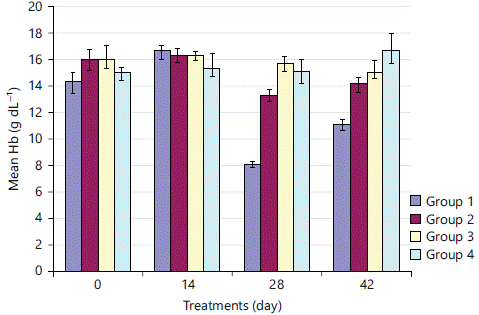
|

|
On days 0 and 14 as presented in Fig. 3, there was no significant difference (p>0.05) in the red blood cell count compared to the control group while on days 28 and 42, there was a significant increase (p<0.05) in the red blood cell count when compared to the control group. The red blood cell count was highest on day 42 with groups 2, 3 and 4 showing higher concentrations compared to the control.
There was no significant difference (p>0.05) in the white blood cell count on days 0 and 14 among the treatment groups when compared to the control but on days 28 and 42, there were significant increases (p<0.05) in white blood cell count within the treatment groups compared to the control, implying that as days of administration of the extract increased, increase in white blood cells occurred. as shown in Fig 4.
There was a significant decrease (p<0.05) in the monocyte count in all the treatment groups when compared to the control group as extract treatments continued from day 1 to 4 in Fig. 5.
Figure 6 showed a significant increase (p<0.05) in the lymphocyte counts within the treatment groups when compared to the untreated control group. The increase in lymphocytes was highest on day 28 with groups 3 and 4 having higher responses to the extract compared to the control.
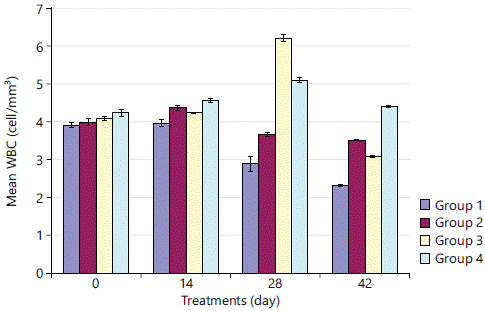
|
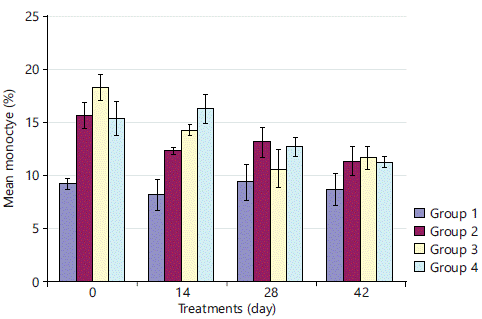
|
On days 0 and 14 as shown in Fig. 7, there was no significant difference (p>0.05) in neutrophil counts among the treatment groups compared to the control but as the administration continued, there was a significant (p<0.05) increase in the neutrophil count within the treatment groups compared to the untreated control group. On day 42, the neutrophil count was highest compared to the other 3 groups.
There were no basophils seen on days 0 and 14. On day 28 there was no significant (p>0.05) change in basophil count among the treatment groups compared to the control. But on day 42, there was a significant (p<0.05) increase in basophils within treatment groups 3 and 4 compared to control group 1 (Fig. 8).
From the result in Fig. 9, the eosinophil count was lowest on day 0 compared to other days. There was a significant (p<0.05) increase in eosinophil count from days 14 to 42 compared to day 0. From days 14 to 42, there was a significant (p<0.05) eosinophil increase among the treatment groups on each day when compared to the untreated control group 1.
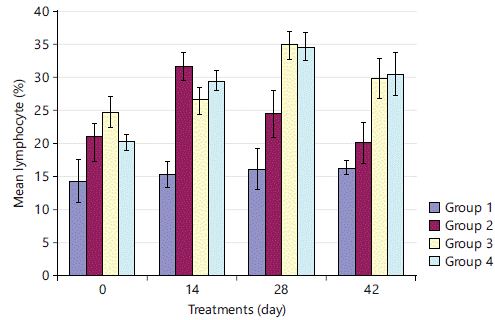
|
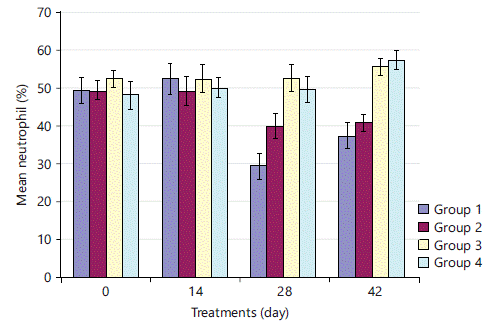
|

|

|
DISCUSSION
From the results of this study, the effects of ethanolic extract of Nauclea latifolia on haematological parameters of the experimental rats after 42 days of administration showed a significant elevation (p<0.05) in Packed Cell Volume (PCV), white blood cell count, haemoglobin concentration, red blood cell count and the white blood cell differentials compared to the control group which could be a protective mechanism against infection. This observation was in agreement with Ismaeel et al.11, Mukinda and Syce12, Awodu et al.13 and in concordance with Busari et al.14 in which methanol and methanol/acetone phenolic-rich extracts of Nauclea latifolia was able to restore haematological abnormalities as well as sustain the integrity of lung tissues of experimental rats. However, this finding was not in agreement with the report of Olusola et al.15 where the observed decrease in RBC count, Hb and PCV was assumed to be associated with retarded haemopoeisis, destruction and shrinkage of RBC after the administration of mistletoe from three host plants i.e. coffee, cola and cocoa to albino rats. The observed increases in RBC, Hb and PCV levels upon administration of ethanolic extract of Nauclea latifolia suggests that the extract could have stimulated erythropoietin release in the kidney, which is the humoral regulators of RBC production16.
The raised haematocrit is an indication of haemo-concentration which may be due to increased RBC mass. The higher values of RBC and associated parameters are suggestive of polycythemia13. The administration of the plant extract also caused a slight increase in the level of haemoglobin. In view of this, the plants can also be of benefit in some anaemic conditions characterized by a decrease in erythrocyte number. Similarly, several medicinal plants such as Xylopia aethiopica17, Tectona grandis18 and extracts of M. indica, A. hybridus and T. occidentalis19 have also been reported to elevate RBC, hemoglobin and packed cell volume. The blood-stimulating effects could be due to the presence of dietary bioactive constituents that stimulate the activities of haematopoietic cells and the stabilization of blood in circulation20. White blood cell counts usually increase following foreign invaders (pathogens) resulting in normal body physiological responses that boost the body’s defense mechanisms21. The increase in WBC and WBC differentials, suggests that the ethanolic extract of N. latifolia root probably contains agents that stimulate the production of leucocytes2. The presence of such agents had been reported in other commonly prescribed medicinal plants22. The crucial role of WBC in defending the body against infection and tissue damage is well known. Thus the results of this study imply that Nauclea latifolia root extract is a potent immuno-stimulant and its use to treat immune-related diseases in herbal medicine can be justified. Such immune boosters are usually recommended to strengthen and harmonize degenerative body systems and assist the immune system to fight invading agents such as bacteria and viruses23.
Evaluation of haematological parameters is not only used to determine the extent of the deleterious effect of herbal extracts but also to explain the functions of plant extracts or their products on the blood of animals11. Haematological parameters provide valuable information on the health status of an animal2. The hematopoietic systems represent a sensitive target of toxic compounds and an essential index of physiological and pathological status in experimental animals. Nevertheless, the mechanism of action of Nauclea latifolia root extract on the hematopoietic systems was not evaluated in this report and therefore it is recommended that further work should be done in this area.
CONCLUSION
In conclusion, most people in developing nations depend on herbal medical care. These herbs are orally administered or can be applied onto the skin surface as an ointment. If the results obtained from this study are applicable to man, ethanolic extracts of Nauclea latifolia root can be used as immune boosters and blood tonics in herbal medicine. Unfortunately, it seems that it may contain particles that may exert or have allergenic and inflammatory properties hence, the need to exercise caution on the excessive or prolonged use of the plant traditionally, especially the crude forms of the root extracts.
SIGNIFICANCE STATEMENT
This study discovered the haematinic capacity of Nauclea latifolia. The ethanolic extract of Nauclea latifolia elevated the packed cell volume, white blood cell count, haemoglobin concentration and red blood cell count in rats. The finding implies that the ethanolic extracts of Nauclea latifolia root can be used as immune boosters and blood tonics in herbal medicine.
REFERENCES
- Tian, X.R., J.T. Feng, Z.Q. Ma, N. Xie, J. Zhang, X. Zhang and H.F. Tang, 2014. Three new glycosides from the whole plant of Clematis lasiandra Maxim and their cytotoxicity. Phytochem. Lett., 10: 168-172.
- Obidike, I.C., M.S. Idris-Usman, L.B. John-Africa and O.A. Salawu, 2011. An evaluation of acute and sub chronic toxicological effects of Hymenocardia acida leaf extract in adult Wistar rats. J. Pharmacol. Toxicol., 6: 400-408.
- Behl, T., A. Gupta, S. Chigurupati, S. Singh and A. Sehgal et al., 2022. Natural and synthetic agents targeting reactive carbonyl species against metabolic syndrome. Molecules, 27: 1583.
- Gidado, A., D.A. Ameh and S.E. Atawodi, 2005. Effects of Nauclea latifolia leaves aqueous extracts on blood glucose levels of normal and alloxan-induced diabetic rats. Afr. J. Biotechnol., 4: 91-93.
- Akpanabiatu, M.I., I.B. Umoh, E.O. Udosen, A.E. Udoh and E.E. Edet, 2005. Rat serum electrolytes, lipid profile and cardiovascular activity on Nauclea latifolia leaf extract administration. Ind. J. Clin. Biochem., 20: 29-34.
- Udobi, C.E., B.E. Umoh and E.G. Asuquo, 2017. Effects of the ethanol extract of the stem bark of Nauclea latifolia Smith [Rubiaceae] on certain biochemical and haematological indices of swiss albino mice. Asian J. Med. Health, 6: 33284.
- Ekmektzoglou, K.A. and G.C. Zografos, 2006. A concomitant review of the effects of diabetes mellitus and hypothyroidism in wound healing. World J. Gastroenterol., 12: 2721-2729.
- Owolabi, O.J., Z.A.M. Nworgu and K. Odushu, 2010. Antidiarrheal evaluation of the ethanol extract of Nauclea latifolia root bark. Methods Find Exp. Clin. Pharmacol., 32: 1440747.
- Abu, M.S., O.E. Yakubu, J.I. Onuche and O. Okpe, 2022. Lipid profiles, hematological parameters and histopathological analysis of CCl4-intoxicated Wistar albino rats treated with n-butanol extract of Ficus glumosa leaves. Cell Biol. Dev., 6: 6-12.
- Gulati, G., G. Uppal and J. Gong, 2022. Unreliable automated complete blood count results: Causes, recognition, and resolution. Cell Biol. Dev., 42: 515-530.
- Ismaeel, B.J., A.D. Mohammad, H.A.H. Fahaid, O.N. Luke, F.S. Hussein, J. Abdul-Moneim and A.K. Mahmoud, 2014. Derangement of hemopoiesis and hematological indices in khat (Catha edulis)-treated rats. Afr. J. Biotechnol., 13: 349-355.
- Mukinda, J.T. and J.A. Syce, 2007. Acute and chronic toxicity of the aqueous extract of Artemisia afra in rodents. J. Ethnopharmacol., 112: 138-144.
- Awodu, O.A., M.E. Enosolease, A.G. Ubaru and A.A. Famodu, 2002. Leucocyte counts in pregnant Nigerian women with sickle cell trait. Afr. J. Reprod. Health, 6: 112-116.
- Busari, M.B., R.U. Hamzah, H.L. Muhammad, R.S. Yusuf, J.O. Adeniyi, Y.O. Ibrahim and J.O. Adakole, 2021. Phenolics-rich extracts of Nauclea latifolia fruit ameliorates lead acetate-induced haematology and lung tissues toxicity in male Wistar rats. Sci. Afr., 11: e00686.
- Olusola, L., O. Matthew and A. Oluwatosin, 2015. Comparative study on the effects of aqueous extracts of Viscum album (Mistletoe) from three host plants on hematological parameters in albino rats. Afr. Health Sci., 15: 606-612.
- Jorum, O.H., N.M. Piero and A.K. Machocho, 2016. Haematological effects of dichloromethane-methanolic leaf extracts of Carissa edulis (Forssk.) Vahl in normal rat models. J. Hematol. Thromboembolic Dis., 4: 1000232.
- Oso, B.J., E.B. Oyewo and A.T. Oladiji, 2019. Influence of ethanolic extracts of dried fruit of Xylopia aethiopica (Dunal) A. Rich on haematological and biochemical parameters in healthy Wistar rats. Clin. Phytosci., 5.
- Diallo, A., M. Gbeassor, A. Vovor, K. Eklu-Gadegbeku and K. Aklikokou et al., 2008. Effect of Tectona grandis on phenylhydrazine-induced anaemia in rats. Fitoterapia, 79: 332-336.
- Agbe, R.J., G.I. Adoga and A.H. Abu, 2010. Antianaemic potentials of some plant extracts on phenyl hydrazine-induced anaemia in rabbits. J. Med. Plants Res., 4: 680-684.
- Anthonia, O.C., U.R. Ikechukwu, N.O. Uzoma and E.L.U. Sunday, 2019. Nutritive properties of aqueous extract Justicia carnea leaves and its effects on haematological and some biochemical indices of anaemia induced male Wistar albino rats. Biomed. Res., 30: 645-654.
- Stover, P.J. and M.A. Caudill, 2008. Genetic and epigenetic contributions to human nutrition and health: Managing genome-diet interactions. J. Am. Diet. Assoc., 108: 1480-1487.
- >Imoru, J.O., A.E. Eno, F.B. Unoh, E.E. Nkanu, O.E. Ofem and J.O. Ibu, 2005. Haematopoietic agent(s) in the crude extract from the leaves of Viscum album (Mistletoe). Niger. J. Health Biomed. Sci., 4: 139-145.
- Al-Mamary, M.A., 2002. Antioxidant activity of commonly consumed vegetables in Yemen. Malays. J. Nutr., 8: 179-189.
How to Cite this paper?
APA-7 Style
Chukwuka,
U.S., Nwadiogbu,
O.V., Yakubu,
O.E., Joshua,
P.E., Egba,
S.I., Godwin,
A.E., Paul-Chima,
U.O., Abu,
M.S., Joseph,
I.T. (2023). Effects of Nauclea latifolia Ethanolic Root Extract on Haematological Indices in Rats. International Journal of Biological Chemistry, 17(1), 10-19. https://doi.org/10.3923/ijbc.2023.10.19
ACS Style
Chukwuka,
U.S.; Nwadiogbu,
O.V.; Yakubu,
O.E.; Joshua,
P.E.; Egba,
S.I.; Godwin,
A.E.; Paul-Chima,
U.O.; Abu,
M.S.; Joseph,
I.T. Effects of Nauclea latifolia Ethanolic Root Extract on Haematological Indices in Rats. Int. J. Biol. Chem 2023, 17, 10-19. https://doi.org/10.3923/ijbc.2023.10.19
AMA Style
Chukwuka
US, Nwadiogbu
OV, Yakubu
OE, Joshua
PE, Egba
SI, Godwin
AE, Paul-Chima
UO, Abu
MS, Joseph
IT. Effects of Nauclea latifolia Ethanolic Root Extract on Haematological Indices in Rats. International Journal of Biological Chemistry. 2023; 17(1): 10-19. https://doi.org/10.3923/ijbc.2023.10.19
Chicago/Turabian Style
Chukwuka, Udeh, Sylvester Michael, Ogugua Vincent Nwadiogbu, Ojochenemi Ejeh Yakubu, Parker Elijah Joshua, Simeon Ikechukwi Egba, Anaduaka Emeka Godwin, Ugwu Okechukwu Paul-Chima, Michael Sunday Abu, and Iornenge Terungwa Joseph.
2023. "Effects of Nauclea latifolia Ethanolic Root Extract on Haematological Indices in Rats" International Journal of Biological Chemistry 17, no. 1: 10-19. https://doi.org/10.3923/ijbc.2023.10.19

This work is licensed under a Creative Commons Attribution 4.0 International License.



